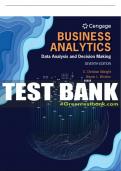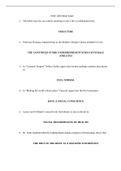KIne Study guides, Class notes & Summaries
Looking for the best study guides, study notes and summaries about KIne? On this page you'll find 4871 study documents about KIne.
Page 3 out of 4.871 results
Sort by
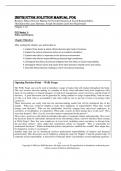
-
Solution Manual for Business Ethics Decision Making for Personal Integrity & Social Responsibility, 5th Edition By Laura Hartman, Joseph DesJardins and Chris MacDonald
- Exam (elaborations) • 297 pages • 2024
-
- $17.49
- 1x sold
- + learn more
Solution Manual for Business Ethics Decision Making for Personal Integrity & Social Responsibility, 5th Edition By Laura Hartman, Joseph DesJardins and Chris MacDonald
Research Methods in Kinesiology, 1e, Kent, Kowalski (Test Bank) Research Methods in Kinesiology, 1e, Kent, Kowalski (Test Bank)
Test Bank For Business Analytics: Data Analysis & Decision Making - 7th - 2020 All Chapters
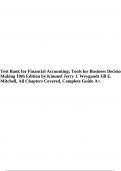
-
Test Bank for Financial Accounting; Tools for Business Decision Making 10th Edition by Kimmel Jerry J. Weygandt Jill E. Mitchell, All Chapters Covered, Complete Guide A+.
- Exam (elaborations) • 1266 pages • 2024
- Available in package deal
-
- $27.99
- 1x sold
- + learn more
Test Bank for Financial Accounting; Tools for Business Decision Making 10th Edition by Kimmel Jerry J. Weygandt Jill E. Mitchell, All Chapters Covered, Complete Guide A+. CHAPTER 1 INTRODUCTION TO FINANCIAL STATEMENTS CHAPTER LEARNING OBJECTIVES 1. Identify the forms of business organization and the uses of accounting information. A sole proprietorship is a business owned by one person. A partnership is a business owned by two or more people associated as partners. A corporation is a separ...
![AQA GCSE COMBINED SCIENCE: TRILOGY 8464/B/2F Biology Paper 2F Version: 1.0 Final *JUN238464B2F01* IB/M/Jun23/E6 8464/B/2F QUESTION PAPER & MARKING SCHEME/ [MERGED]](/docpics/4384298/65ba760a14369_4384298_121_171.jpeg)
-
AQA GCSE COMBINED SCIENCE: TRILOGY 8464/B/2F Biology Paper 2F Version: 1.0 Final *JUN238464B2F01* IB/M/Jun23/E6 8464/B/2F QUESTION PAPER & MARKING SCHEME/ [MERGED]
- Exam (elaborations) • 60 pages • 2024
- Available in package deal
-
- $7.99
- 2x sold
- + learn more
GCSE COMBINED SCIENCE: TRILOGY 8464/B/2F Biology Paper 2F Version: 1.0 Final *JUN238464B2F01* IB/M/Jun23/E6 8464/B/2F For Examiner’s Use Question Mark 1 2 3 4 5 6 7 TOTAL Friday 9 June 2023 Afternoon Time allowed: 1 hour 15 minutes Materials For this paper you must have: • a ruler • a scientific calculator. Instructions • Use black ink or black ball-point pen. • Pencil should only be used for drawing. • Fill in the boxes at the top of this page. • Answer a...
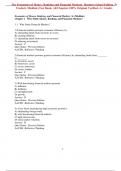
-
The Economics of Money, Banking and Financial Markets, Business School Edition, 5e Frederic Mishkin (Test Bank All Chapters, 100% original verified, A+ Grade)
- Exam (elaborations) • 659 pages • 2023
- Available in package deal
-
- $27.49
- 1x sold
- + learn more
The Economics of Money, Banking and Financial Markets, Business School Edition, 5e Frederic Mishkin (Test Bank All Chapters, 100% original verified, A+ Grade) The Economics of Money, Banking and Financial Markets, Business School Edition, 5e Frederic Mishkin (Test Bank All Chapters, 100% original verified, A+ Grade)

-
TEST BANK For Business Data Communications and Networking, 14th Edition by FitzGerald, Dennis, Durcikova | Verified Chapter's 1 - 12 | Complete
- Exam (elaborations) • 229 pages • 2023
-
- $15.49
- 2x sold
- + learn more
TEST BANK For Business Data Communications and Networking, 14th Edition by FitzGerald, Dennis, Durcikova | Verified Chapter's 1 - 12 | Complete This TEST BANK covers various aspects of business data communications and networking. It provides a comprehensive overview of the principles, technologies, and practices involved in transmitting data within a business environment. The book covers topics such as network architecture, protocols, network security, wireless networks, cloud computing, and...
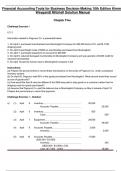
-
Complete Solution Manual Financial Accounting Tools for Business Decision Making 10th Edition Kimmel Weygandt Mitchell (Chapter 1-13)
- Exam (elaborations) • 1785 pages • 2023
-
- $16.99
- 1x sold
- + learn more
Financial Accounting Tools for Business Decision Making 10th Edition Kimmel Weygandt Mitchell Solution Manual Complete Solution Manual Financial Accounting Tools for Business Decision Making 10th Edition Kimmel Weygandt Mitchell (Chapter 1-13) PDF File All Pages All Chapters Grade A+
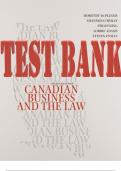
-
TEST BANK for Canadian Business and the Law 7th Edition by Duplessis, O'Byrne, King, Adams & Enman. (Complete Chapters 1-28)
- Exam (elaborations) • 445 pages • 2023
-
- $37.57
- 2x sold
- + learn more
TEST BANK for Canadian Business and the Law 7th Edition by Duplessis, O'Byrne, King, Adams & Enman. (Complete Chapters 1-28)

$6.50 for your textbook summary multiplied by 100 fellow students... Do the math: that's a lot of money! Don't be a thief of your own wallet and start uploading yours now. Discover all about earning on Stuvia


